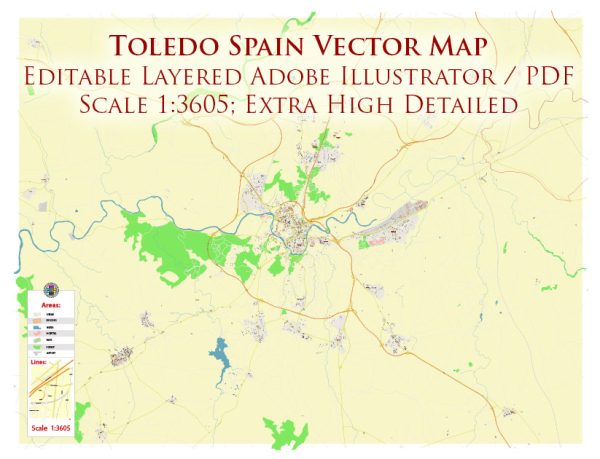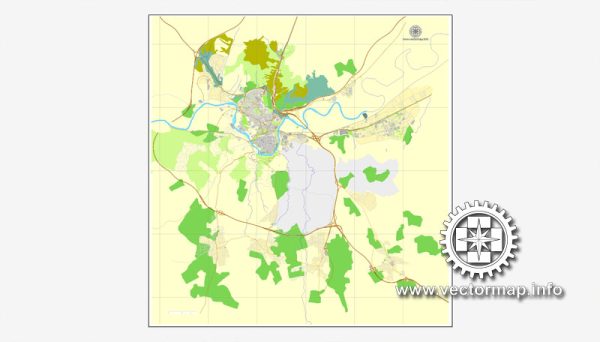Geographic Description of Toledo, Spain
Location:
Toledo is located in central Spain, in the autonomous community of Castilla-La Mancha. The city sits on a rocky hilltop overlooking the Tagus River (known as Río Tajo in Spanish), which encircles the city on three sides, forming a natural moat. It lies about 70 kilometers (43 miles) southwest of Madrid, making it easily accessible from the Spanish capital.
Geography and Topography:
- Elevations and Surroundings: The city is perched at an elevation of approximately 529 meters (1,736 feet) above sea level. The surrounding landscape is predominantly rolling hills and plains, with fertile lands that have historically supported agriculture.
- Tagus River: The river played a strategic and economic role, serving as a defense barrier and a trade route. It also contributes to the scenic beauty of the area.
- Urban Layout: Toledo is characterized by its labyrinthine streets, narrow alleyways, and a compact historic core. The city’s medieval design reflects its layered history, with influences from Roman, Visigothic, Islamic, Jewish, and Christian periods.
Climate:
Toledo has a Mediterranean climate with continental influences. Summers are hot and dry, with temperatures often exceeding 35°C (95°F), while winters are cold, with occasional frosts. Rainfall is sparse, mostly occurring in autumn and spring.
Brief History of Toledo
Ancient and Roman Times:
Toledo’s origins date back to the Bronze Age, around 2,500 BCE, making it one of the oldest cities in Spain. The Romans established it as Toletum, an important provincial city known for its strategic location and metalworking, especially in steel and gold.
Visigothic Era (5th–8th centuries):
After the fall of the Roman Empire, Toledo became the capital of the Visigothic Kingdom in the 6th century. It was a significant religious and political center, as evidenced by the Councils of Toledo, which shaped early Christian doctrine and law in the Iberian Peninsula.
Islamic Rule (711–1085):
Toledo fell to the Moors in 711 and flourished under Islamic rule as Tulaytulah. It became a cultural melting pot where Muslims, Christians, and Jews coexisted, contributing to advancements in science, philosophy, and the arts. The city was renowned for its libraries and intellectual achievements.
Christian Reconquest and Medieval Period (1085–15th century):
King Alfonso VI of Castile captured Toledo in 1085 during the Reconquista. It became a model of convivencia (coexistence) among the three Abrahamic religions. Toledo’s School of Translators was pivotal in transferring Islamic and classical knowledge to Western Europe, especially works by Aristotle and other ancient philosophers.
Golden Age (16th century):
In the 16th century, Toledo was the imperial capital under Charles V (Carlos I of Spain). During this period, the city became a hub of Renaissance culture and art, most famously associated with the painter El Greco, whose works define much of Toledo’s cultural heritage.
Modern Period:
Toledo’s importance declined when the capital moved to Madrid in 1561. However, its historical and architectural significance preserved it as a cultural landmark. It was declared a UNESCO World Heritage Site in 1986 for its well-preserved medieval architecture, including churches, mosques, synagogues, and the Alcázar fortress.
Key Features and Attractions
- Toledo Cathedral: A masterpiece of Gothic architecture with Mudéjar and Renaissance elements, completed in the 15th century.
- Alcázar of Toledo: A fortress that dominates the city skyline, with a history dating back to Roman times. It played a crucial role during the Spanish Civil War.
- El Greco Museum: Celebrates the works of El Greco, showcasing his unique style and contributions to Spanish art.
- Synagogue of Santa María la Blanca: A symbol of Toledo’s Jewish heritage and an example of Mudéjar architecture.
- Puente de Alcántara and Puente de San Martín: Iconic medieval bridges over the Tagus River.
Toledo’s enduring charm lies in its fusion of cultures and its status as a living museum of Spanish history.



 Author: Kirill Shrayber, Ph.D.
Author: Kirill Shrayber, Ph.D.